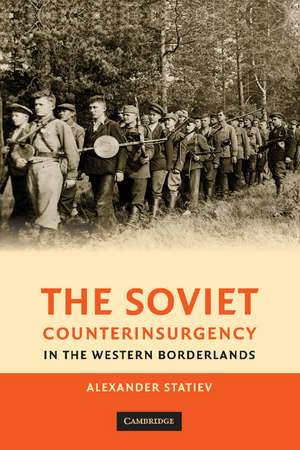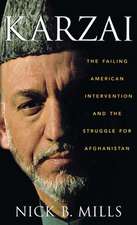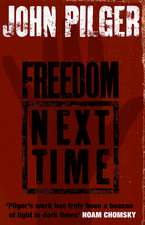The Soviet Counterinsurgency in the Western Borderlands
Autor Alexander Statieven Limba Engleză Paperback – 21 aug 2013
| Toate formatele și edițiile | Preț | Express |
|---|---|---|
| Paperback (1) | 275.85 lei 6-8 săpt. | |
| Cambridge University Press – 21 aug 2013 | 275.85 lei 6-8 săpt. | |
| Hardback (1) | 757.52 lei 6-8 săpt. | |
| Cambridge University Press – 18 apr 2010 | 757.52 lei 6-8 săpt. |
Preț: 275.85 lei
Nou
Puncte Express: 414
Preț estimativ în valută:
52.80€ • 57.37$ • 44.38£
52.80€ • 57.37$ • 44.38£
Carte tipărită la comandă
Livrare economică 21 aprilie-05 mai
Preluare comenzi: 021 569.72.76
Specificații
ISBN-13: 9781107616479
ISBN-10: 1107616476
Pagini: 386
Ilustrații: 3 b/w illus. 1 map 30 tables
Dimensiuni: 156 x 234 x 22 mm
Greutate: 0.59 kg
Editura: Cambridge University Press
Colecția Cambridge University Press
Locul publicării:New York, United States
ISBN-10: 1107616476
Pagini: 386
Ilustrații: 3 b/w illus. 1 map 30 tables
Dimensiuni: 156 x 234 x 22 mm
Greutate: 0.59 kg
Editura: Cambridge University Press
Colecția Cambridge University Press
Locul publicării:New York, United States
Cuprins
Introduction; 1. Origins of Soviet counterinsurgency; 2. The borderland societies in the interwar period: the first Soviet occupation and the emergence of nationalist resistance; 3. The borderlands under German occupation (1941–4): social context of the Soviet re-conquest; 4. Nationalist resistance after the Soviet re-conquest; 5. Soviet agrarian policy as a pacification tool; 6. Deportations, 'repatriations' and other types of forced migrations as aspects of security policy; 7. Amnesties; 8. Red rurales: the destruction battalions; 9. Police tactics: actions of NKVD security units, intelligence gathering, covert operations and intimidation; 10. The church in Soviet security policy; 11. Violations of official policy and their impact on pacification; 12. Conclusion: nationalist resistance and Soviet counterinsurgency in the global context; Appendix 1. Note on used terms and geographic and personal names; Appendix 2. Note on primary sources.
Recenzii
Review of the hardback: 'The Soviet Union's annexation of western borderlands at the end of World War II sparked fierce insurgencies against Soviet rule, especially in western Ukraine and the Baltic states. Alexander Statiev draws extensively on Russian archival sources to provide a detailed, insightful account of the Soviet regime's counterinsurgency doctrine in those regions. No previous study in English has addressed this topic in such depth and such breadth. Even those who would challenge some of Statiev's conclusions and findings can be grateful for the immense amount of research he has done.' Mark Kramer, Harvard University
Review of the hardback: 'One of the most obscure aspects of Soviet history has long been the violent pacification of the Soviet borderlands after the end of World War II. Professor Statiev has for the first time produced a strikingly original, honest, and comprehensive account of that hidden history. Free of polemic and prejudice, his account will become the standard work.' Richard Overy, University of Exeter
Review of the hardback: 'Statiev's book provides an insightful and meticulous look at the postwar counterinsurgency campaigns in the Soviet Union's western borderlands, shedding new light on the ruthless struggle for control from the Baltics to Ukraine.' Dave Stone, Kansas State University
'… Statiev has certainly produced a work that is both a valuable contribution to the literature on Soviet nationalities policy and counterinsurgency, and one that should provide material of interest to a wide academic audience.' Alexander Hill, Canadian Slavonic Papers
'Statiev refutes the historiography's neat dichotomy between foreign usurpers persecuting the national freedom fighters of Ukraine and the Baltic states. Rather, he characterizes the conflict as a civil war fought on the village level, neighbor against neighbor. He provides numbers transformed into charts from archival and secondary sources to show that Ukrainians and Balts made up not only most of the insurgents but also the majority of counterinsurgents (in destruction battalions and village militias).' Kate Brown, Slavic Review
Review of the hardback: 'One of the most obscure aspects of Soviet history has long been the violent pacification of the Soviet borderlands after the end of World War II. Professor Statiev has for the first time produced a strikingly original, honest, and comprehensive account of that hidden history. Free of polemic and prejudice, his account will become the standard work.' Richard Overy, University of Exeter
Review of the hardback: 'Statiev's book provides an insightful and meticulous look at the postwar counterinsurgency campaigns in the Soviet Union's western borderlands, shedding new light on the ruthless struggle for control from the Baltics to Ukraine.' Dave Stone, Kansas State University
'… Statiev has certainly produced a work that is both a valuable contribution to the literature on Soviet nationalities policy and counterinsurgency, and one that should provide material of interest to a wide academic audience.' Alexander Hill, Canadian Slavonic Papers
'Statiev refutes the historiography's neat dichotomy between foreign usurpers persecuting the national freedom fighters of Ukraine and the Baltic states. Rather, he characterizes the conflict as a civil war fought on the village level, neighbor against neighbor. He provides numbers transformed into charts from archival and secondary sources to show that Ukrainians and Balts made up not only most of the insurgents but also the majority of counterinsurgents (in destruction battalions and village militias).' Kate Brown, Slavic Review
Notă biografică
Descriere
This book investigates the Soviet response to nationalist insurgencies between 1944 and 1953 in the regions the Soviet Union annexed after the Nazi-Soviet pact.
















